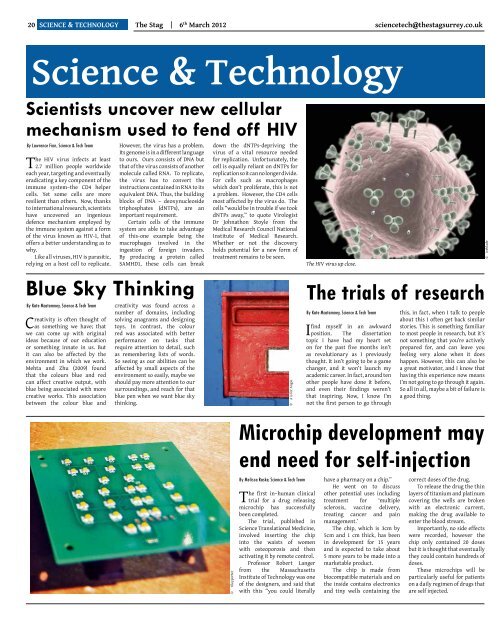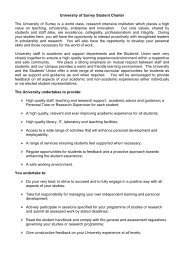Issue 43 - University of Surrey's Student Union
Issue 43 - University of Surrey's Student Union
Issue 43 - University of Surrey's Student Union
You also want an ePaper? Increase the reach of your titles
YUMPU automatically turns print PDFs into web optimized ePapers that Google loves.
20 SCIENCE & TECHNOLOGY The Stag | 6 th March 2012 sciencetech@thestagsurrey.co.uk<br />
Science & Technology<br />
Scientists uncover new cellular<br />
mechanism used to fend <strong>of</strong>f HIV<br />
By Lawrence Finn, Science & Tech Team<br />
The HIV virus infects at least<br />
2.7 million people worldwide<br />
each year, targeting and eventually<br />
eradicating a key component <strong>of</strong> the<br />
immune system–the CD4 helper<br />
cells. Yet some cells are more<br />
resilient than others. Now, thanks<br />
to international research, scientists<br />
have uncovered an ingenious<br />
defence mechanism employed by<br />
the immune system against a form<br />
<strong>of</strong> the virus known as HIV-1, that<br />
<strong>of</strong>fers a better understanding as to<br />
why.<br />
Like all viruses, HIV is parasitic,<br />
relying on a host cell to replicate.<br />
However, the virus has a problem.<br />
Its genome is in a different language<br />
to ours. Ours consists <strong>of</strong> DNA but<br />
that <strong>of</strong> the virus consists <strong>of</strong> another<br />
molecule called RNA. To replicate,<br />
the virus has to convert the<br />
instructions contained in RNA to its<br />
equivalent DNA. Thus, the building<br />
blocks <strong>of</strong> DNA – deoxynucleoside<br />
triphosphates (dNTPs), are an<br />
important requirement.<br />
Certain cells <strong>of</strong> the immune<br />
system are able to take advantage<br />
<strong>of</strong> this-one example being the<br />
macrophages involved in the<br />
ingestion <strong>of</strong> foreign invaders.<br />
By producing a protein called<br />
SAMHD1, these cells can break<br />
down the dNTPs-depriving the<br />
virus <strong>of</strong> a vital resource needed<br />
for replication. Unfortunately, the<br />
cell is equally reliant on dNTPs for<br />
replication so it can no longer divide.<br />
For cells such as macrophages<br />
which don’t proliferate, this is not<br />
a problem. However, the CD4 cells<br />
most affected by the virus do. The<br />
cells “would be in trouble if we took<br />
dNTPs away,” to quote Virologist<br />
Dr Johnathon Stoyle from the<br />
Medical Research Council National<br />
Institute <strong>of</strong> Medical Research.<br />
Whether or not the discovery<br />
holds potential for a new form <strong>of</strong><br />
treatment remains to be seen.<br />
The HIV virus up close.<br />
© iceblade<br />
Blue Sky Thinking<br />
By Kate Mcatamney, Science & Tech Team<br />
Creativity is <strong>of</strong>ten thought <strong>of</strong><br />
as something we have; that<br />
we can come up with original<br />
ideas because <strong>of</strong> our education<br />
or something innate in us. But<br />
it can also be affected by the<br />
environment in which we work.<br />
Mehta and Zhu (2009) found<br />
that the colours blue and red<br />
can affect creative output, with<br />
blue being associated with more<br />
creative works. This association<br />
between the colour blue and<br />
creativity was found across a<br />
number <strong>of</strong> domains, including<br />
solving anagrams and designing<br />
toys. In contrast, the colour<br />
red was associated with better<br />
performance on tasks that<br />
require attention to detail, such<br />
as remembering lists <strong>of</strong> words.<br />
So seeing as our abilities can be<br />
affected by small aspects <strong>of</strong> the<br />
environment so easily, maybe we<br />
should pay more attention to our<br />
surroundings, and reach for that<br />
blue pen when we want blue sky<br />
thinking.<br />
© A is for Angie<br />
The trials <strong>of</strong> research<br />
By Kate Mcatamney, Science & Tech Team<br />
find myself in an awkward<br />
I position. The dissertation<br />
topic I have had my heart set<br />
on for the past five months isn’t<br />
as revolutionary as I previously<br />
thought. It isn’t going to be a game<br />
changer, and it won’t launch my<br />
academic career. In fact, around ten<br />
other people have done it before,<br />
and even their findings weren’t<br />
that inspiring. Now, I know I’m<br />
not the first person to go through<br />
this, in fact, when I talk to people<br />
about this I <strong>of</strong>ten get back similar<br />
stories. This is something familiar<br />
to most people in research, but it’s<br />
not something that you’re actively<br />
prepared for, and can leave you<br />
feeling very alone when it does<br />
happen. However, this can also be<br />
a great motivator, and I know that<br />
having this experience now means<br />
I’m not going to go through it again.<br />
So all in all, maybe a bit <strong>of</strong> failure is<br />
a good thing.<br />
Microchip development may<br />
end need for self-injection<br />
© rileyporter<br />
By Melissa Raske, Science & Tech Team<br />
The first in–human clinical<br />
trial for a drug releasing<br />
microchip has successfully<br />
been completed.<br />
The trial, published in<br />
Science Translational Medicine,<br />
involved inserting the chip<br />
into the waists <strong>of</strong> women<br />
with osteoporosis and then<br />
activating it by remote control.<br />
Pr<strong>of</strong>essor Robert Langer<br />
from the Massachusetts<br />
Institute <strong>of</strong> Technology was one<br />
<strong>of</strong> the designers, and said that<br />
with this “you could literally<br />
have a pharmacy on a chip.”<br />
He went on to discuss<br />
other potential uses including<br />
treatment for ‘multiple<br />
sclerosis, vaccine delivery,<br />
treating cancer and pain<br />
management.’<br />
The chip, which is 3cm by<br />
5cm and 1 cm thick, has been<br />
in development for 15 years<br />
and is expected to take about<br />
5 more years to be made into a<br />
marketable product.<br />
The chip is made from<br />
biocompatible materials and on<br />
the inside contains electronics<br />
and tiny wells containing the<br />
correct doses <strong>of</strong> the drug.<br />
To release the drug the thin<br />
layers <strong>of</strong> titanium and platinum<br />
covering the wells are broken<br />
with an electronic current,<br />
making the drug available to<br />
enter the blood stream.<br />
Importantly, no side effects<br />
were recorded, however the<br />
chip only contained 20 doses<br />
but it is thought that eventually<br />
they could contain hundreds <strong>of</strong><br />
doses.<br />
These microchips will be<br />
particularly useful for patients<br />
on a daily regimen <strong>of</strong> drugs that<br />
are self injected.

















